Co-authors: Yu Ce (Gong Zhigang), Sun Jiang (Lin Lixiang), Fei Lian (Wang Zhiming), Yun Long (You Liang)
In recent years, deep learning has witnessed fast development in fields such as image recognition and NLP. More and more computing power is needed to train a variety of network models.
Take the typical medium-scale image classification network ResNet-50 for example. The basic training accuracy is Top-1 76%, and the Top-5 accuracy is 93%. To reach this accuracy, generally it is required to have 90 epoches of the 1.28 million images in the entire Imagenet dataset. It takes six days for a single P100 computing processor to perform such a large number of computations and complete the training. It will take months or years to complete the training if the recent groundbreaking BERT model or the pre-training model GPT-2 is applied on a single machine.
Therefore, it is urgent to use distributed training in the actual production environment to reduce the time required for model training and improve the model iteration speed. To meet this urgent need, major deep learning frameworks have basically implemented support for distributed training.
| Parameter server (PS) | MPI(NCCL) | |
| Tensorflow | Y | Y (Horovod) |
| MXNet | Y | Y (Horovod) |
| Pytorch | N | Y (Horovod, Gloo) |
| Caffe | N | Y (NVCaffe) |
According to our experiences, the existing distributed training frameworks have the following problems in the cloud environment:
These three issues indicate the same trend, that is, to unify the distributed communication of individual frameworks into one single architecture. We noticed that the open-source Horovod project have partially solved the preceding issues. Currently, Horovod supports TensorFlow, PyTorch, and Keras. Recently, it also added support for MXNet. Horovod serves as a good reference. The unified distributed communication framework is feasible, and gradient synchronization communication can be abstracted into framework-independent architectures. However, the biggest problem in Horovod is that it does not solve the challenge of the scalability on the cloud.
After our discussion, we decided to develop a completely independent project: Ali-Perseus and create a highly optimized and unified distributed communication framework for deep learning on Alibaba Cloud.
After considering the characteristics of Alibaba Cloud infrastructure, we developed a completely independent universal distributed framework. In addition to TensorFlow and PyTorch supported in Horovod, we also added support for MXNet and Caffe based on the needs of our main AI users. The following figure shows the system architecture.
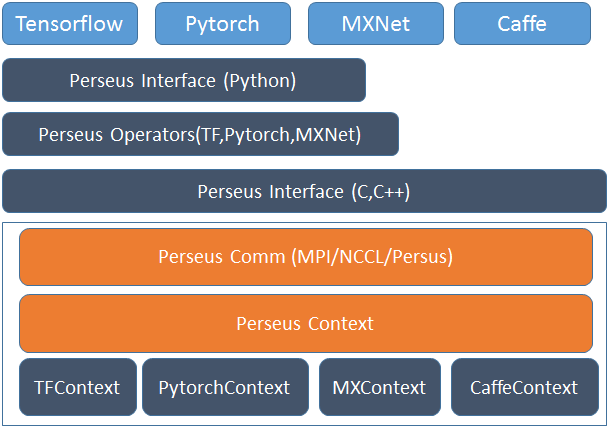
Block diagram of the Ali-Perseus training communication framework
The goal of this system design is to make all communication-related operations transparent to upper-layer training framework and split support for different frameworks into mutually independent modules. To implement this goal, we implemented the following module design:
The communication framework needs to provide two types of interfaces: Python interfaces and C interfaces. The interface layer is required to provide the following features for performing upper-layer model training tasks:
For MXNet, PyTorch, and TensorFlow, it is required to prepare Python interfaces for corresponding features; for Caffe, it is only required to provide C interfaces. For detailed description of Python interfaces for individual frameworks, see the Framework layer section.
The interfaces in the communication layer are divided into two simple types of APIs:
Before each framework has gradient reduction communication, it is required to register a gradient first. The parameter in the registration process is the name of the unique identifier of the upper-layer training framework in that gradient. A value is assigned internally to represent that gradient. Then gradient communication can be implemented. An interface adds the corresponding gradient to the communication queue and marks the communication type as broadcast or Allreduce. At the same time, it is also required to register a callback function. When the distributed communication finishes, the callback function will be invoked to notify the upper-layer training framework that the gradient communication has already been completed and that it is ready to perform the subsequent parameter update operation. All gradient communication details do not need to be exposed to any interfaces.
The following block diagram shows the internal modules in the communication layer.
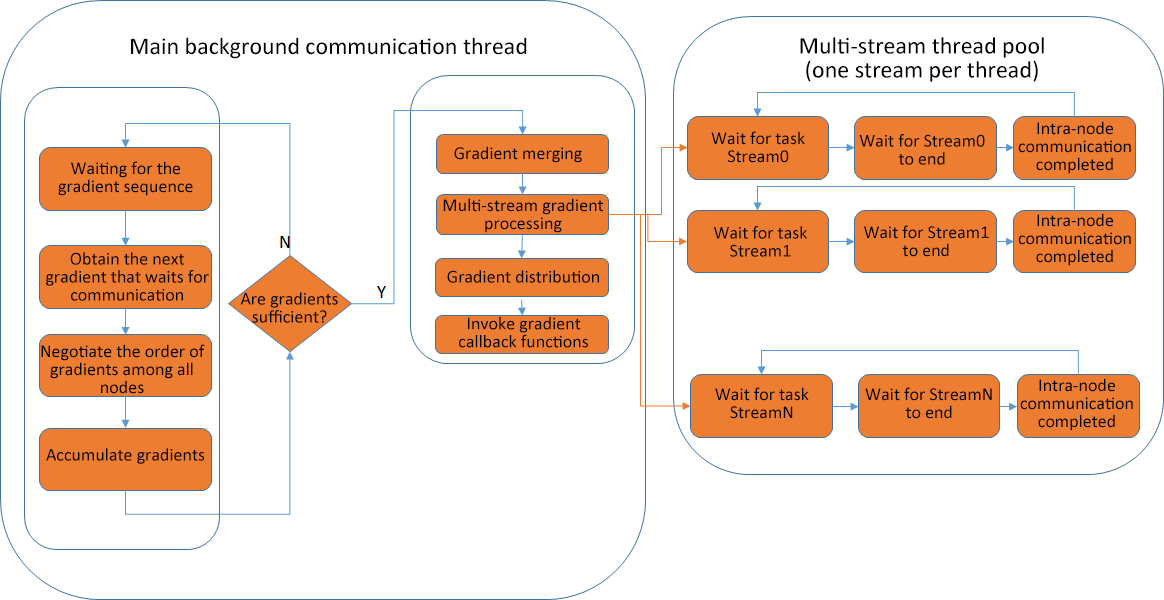
Ali-Perseus communication modules
The main communication work is done in the main background thread and asynchronous waiting is done in the multi-stream thread pool. This asynchronous multi-stream approach can minimize the global impact of a single slow connection. The following are the main steps:
The main thread processes the gradients that wait for communication.
Multi-stream thread pool
In the communication layer, more underlying primitives that implements the actual communication are encapsulated. Currently, two communication patterns are supported:
TensorFlow and PyTorch
After considering the wide popularity of Horovod and its support for TensorFlow and PyTorch, for the Python interfaces supported in the framework layer of these two frameworks, we decided to choose interfaces that are fully consistent with Horovod so that users can seamlessly integrate their existing model codes into the Ali-Perseus communication library with almost zero conversion cost. For the parts that connects to the framework layer, it is only required to define their own Tensors and the virtual implementations targeting Context. This is not a complicated process.
After the implementation, simply replace the distributed models that use Horovod:
# For tensorflow with horovod
sed -i 's/import horovod.tensorflow as/import perseus.tensorflow.horovod as/g' model.py
# For pytorch with horovod
sed -i 's/import horovod.torch as/import perseus.torch.horovod as/g' model.pyMXNet
Support for MXNet will not be explained here again.
Caffe
Because Caffe provides relatively primitive distributed support and is not modular, support for Caffe is relatively more difficult compared with the three other frameworks. The support for the three preceding frameworks does not require any changes to the framework code, except few modifications to MXNet. However, we need to make many modifications to the Caffe framework, which mainly include the following:
Ali-Perseus also needs to add proper implementations of Caffe. Finally, after the integration, Ali-Perseus can support multiple machines and machines in Caffe.
After implementing the preceding architecture, we have integrated the distributed communication of all the training frameworks into one framework. All optimization work in this communication framework will directly benefit all the training frameworks. Most of our optimization work in the first phase is related to the VPC network depth. Optimization in this phase generally falls into two types:
After profiling the NCCL implementation method in Horovod, we found that it was very difficult to reach the upper limit of the network bandwidth on the cloud. We made analysis and confirmed that the main reason was the single-stream communication in the TCP network. This was further evidenced by using Iperf. Therefore, we decided to use sharding and multiple streams. For sharding and multiple streams, a relatively simple sharding method is to perform sharding targeting gradients merged at a time and implement multi-stream communication. This method is simple and does not need to process different collections of merged gradients in parallel. However, this method has one disadvantage: The communication for the next time has to wait until all shards merged and the split this time completes the communication. We further found that individual streams under the multi-stream communication model have drastically different communication speeds. Therefore, we finally chose the combination of multiple gradients and multiple streams. This method has much more complicated control logic and the whole processing procedure has to be split into the upper half part and the lower half part. The upper half part is responsible for merging, reduction within nodes, and communication among nodes. The lower half part is responsible broadcasting results to individual nodes. During this process, be careful with the relationship among multiple streams in NCCL to prevent Hang.
Latency is generally not a major issue in the distributed training of deep learning models. However, this is not the case for large-scale distributed training. An artificial single-point hot spot will be generated during gradient negotiation for gradient data communication. In Horovod, all nodes will negotiate with the root node and the root node then coordinates all nodes. The burden on the root node will increase significantly as the number of nodes grows. One of our customers has 320 nodes in the CTR scenario. The overhead of negotiation causes the root node to completely lose scalability. By reforming the negotiation algorithm and deprecating the central point-to-point negotiation model in Horovod, we have reduced the complexity of gradient negotiation by one or two orders of magnitude. Scalability is also achieved in the aforementioned CTR scenario.
After the two optimizations, we found that some parameters need fine-tuning, such as the merging granularity and the sharding granularity. It is very hard to configure these parameters offline. We must find optimal configuration for these parameters in a dynamic manner. The following is our main optimization work related to communication:
After the overall implementation of the architecture and communication performance optimization, we compared the performance of distributed training for different libraries and found that for most network models, Horovod shows better performance than these libraries themselves. Ali-Perseus has better performance than Horovod. Generally, Ali-Perseus shows obvious performance advantages in the two following cases:
The following charts show performance tests and performance comparison in the process of supporting our customers. Some network models using Ali-Perseus have been used in the production environment of our customers.
TensorFlow BERT Base Model
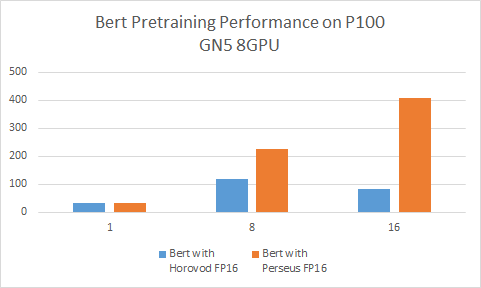
TensorFlow BERT Base Model with Ali-Perseus shows 200%-500% better performance than Horovod
TensorFlow ResNet-18
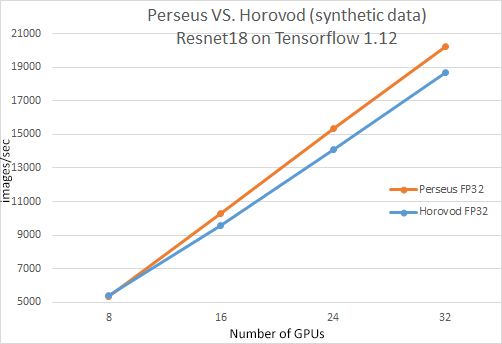
The scalability of ResNet-18 (synthetic data) in Ali-Perseus on 4 machines and 32 GPUs is increased to 94.2% (86.4% in MXNet)
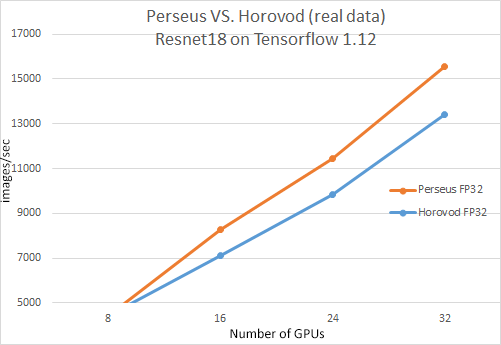
The scalability of ResNet-18 (real data) in Ali-Perseus on 4 machines and 32 GPUs is increased to 87.4% (75.9% in MXNet)
MXNet ResNet-50
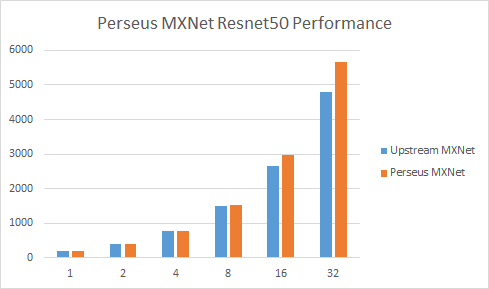
The scalability of ResNet-50 on 4 machines and 32 GPUs is increased to 91.9% (79.4% in MXNet)
The implementation of this universal distributed communication framework for deep learning decouples distributed optimizations of deep learning frameworks from frameworks themselves and allows us to perform deep optimizations of Alibaba Cloud infrastructure in a unified framework. The deep VPC network optimization in the first phase allows Tensorflow, MXNet, Pytorch, and Caffe to improve the multiple-machine scalability on Alibaba Cloud, significantly improves the platform optimization efficiency and reduces the post maintenance workload. Currently, some customers are in the following stages of using Ali-Perseus:
Our customers can retain their original open-source training frameworks while utilizing the performance advantages of Ali-Perseus. This is an acceptable solution for most customers. IaaS resources that our customers have purchased also have direct performance gains and the heterogeneous computing products from Alibaba Cloud have a higher cost-effectiveness.
The latest release of Ali-Perseus 0.9.4 supports Python 2.7 and 3.6, Centos 7, and Ubuntu 16.04, as shown in the following figure. The following are the main features of Ali-Perseus:
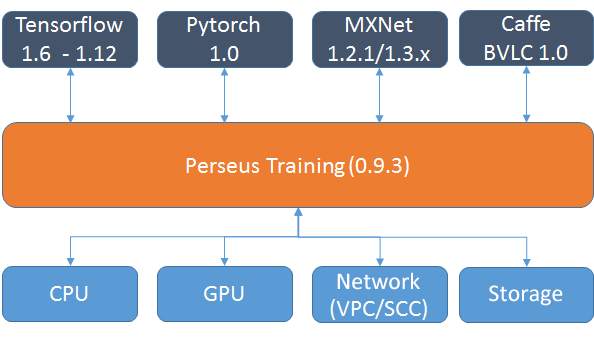
Main components of Ali-Perseus training communication framework
Dubbo Metrics: Exploring the Measurement and Statistics Infrastructure of Dubbo

2,598 posts | 770 followers
FollowAlibaba Clouder - October 22, 2019
youliang - February 5, 2021
Alibaba Clouder - January 22, 2020
Alibaba Clouder - April 19, 2019
Alibaba Clouder - October 23, 2020
Alibaba F(x) Team - December 14, 2020

2,598 posts | 770 followers
Follow Platform For AI
Platform For AI
A platform that provides enterprise-level data modeling services based on machine learning algorithms to quickly meet your needs for data-driven operations.
Learn More Epidemic Prediction Solution
Epidemic Prediction Solution
This technology can be used to predict the spread of COVID-19 and help decision makers evaluate the impact of various prevention and control measures on the development of the epidemic.
Learn More Online Education Solution
Online Education Solution
This solution enables you to rapidly build cost-effective platforms to bring the best education to the world anytime and anywhere.
Learn More Accelerated Global Networking Solution for Distance Learning
Accelerated Global Networking Solution for Distance Learning
Alibaba Cloud offers an accelerated global networking solution that makes distance learning just the same as in-class teaching.
Learn MoreMore Posts by Alibaba Clouder